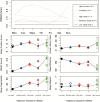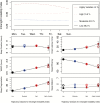Weekly sleep trajectories and their associations with obesity and hypertension in the Hispanic/Latino population
- PMID: 30053253
- PMCID: PMC6187108
- DOI: 10.1093/sleep/zsy150
Weekly sleep trajectories and their associations with obesity and hypertension in the Hispanic/Latino population
Abstract
Study objectives: To identify weekly sleep trajectories (sleep pattern changing by day over a course of week) of specific characteristics and examine the associations between trajectory classes and obesity and hypertension.
Methods: A total of 2043 participants (mean age 46.9, 65.5% female) completed at least 7 days of actigraphy aged 18-64 from the Sueño ancillary study of the Hispanic Community Health Study/Study of Latinos (HCHS/SOL). Weekly sleep trajectories for three daily level measures (wake after sleep onset [WASO], daytime napping duration, and intranight instability index) were identified using latent class growth models. The outcomes were obesity and hypertension.
Results: Using the trajectory with low-stable WASO as reference, the trajectory classes with increasing and high-concave patterns had significantly higher odds for obesity (OR 3.64 [1.23-10.84]) and hypertension (OR 5.25 [1.33, 20.82]), respectively. Compared with individuals with a low-stable napping duration trajectory, those with the high-concave pattern class were associated with hypertension (OR 2.27 [1.10-4.67]), and the association was mediated in part by obesity (OR 1.11 [1.00-1.22]). Individuals in the high intranight instability index trajectory had significantly larger likelihood for both obesity (OR 1.90 [1.26-2.86]) and hypertension (OR 1.86 [1.13-3.06]) compared with those in the low intranight instability index trajectory.
Conclusions: Weekly trajectories varied for WASO, daytime napping duration, and intranight instability index. The trajectories with relatively larger values for these three measures were associated with greater risk for obesity and hypertension. These findings suggest that a stable pattern with relatively small weekly and nightly variability may be beneficial for cardiovascular health.
Figures



References
Publication types
MeSH terms
Grants and funding
- K24 HL127307/HL/NHLBI NIH HHS/United States
- N01HC65236/NHLBI NIH HHS/National Heart, Lung, and Blood Institute/United States
- P30 DK111022/DK/NIDDK NIH HHS/United States
- N01HC65233/NHLBI NIH HHS/National Heart, Lung, and Blood Institute/United States
- N01HC65235/NHLBI NIH HHS/National Heart, Lung, and Blood Institute/United States
LinkOut - more resources
Full Text Sources
Other Literature Sources
Medical

